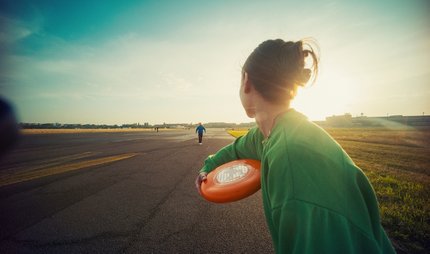
Off to the green spaces
Green spaces in in Tempelhof-Schöneberg
Sure, Berlin has many green spaces – the Tiergarten, the Südgelände in Schöneberg and the great expanse of the Tempelhofer Feld. But it’s the little parks and gardens that give the city space to breathe and where you can find secluded spaces to relax and recharge. And Tempelhof-Schöneberg has quite a few of them.
The informative Naturpark Marienfelde in the south of Tempelhof at the edge of the Mariengrün estate consists of a nature reserve and an educational unit. The site covers 40 hectares and is not just a paradise for wildlife enthusiasts. A biotope has developed here where an extraordinary variety of species have settled, including rare moor frogs, sand lizards and spadefoot toads. Or you can also watch deer and wild boar. Walking along the 1.5-kilometre nature trail you’ll hear animals in the undergrowth and see their tracks on the paths.
A garden in the backyard: Ceciliengärten
Further north, you can also relax around Tempelhofer Damm in a string of green spaces consisting of Bosepark and Lehnepark, the Alter Park and Franckepark. Here you can see weathered gravestones, the cemetery of the picturesque old Tempelhof village church, lakes formed by glacial ice, a fallow deer enclosure and beautiful old trees.
Follow the green trail to the west, past the Südgelände Schöneberg, then you’ll come to the Ceciliengärten. The gardens and estate were named after Princess Cecilie of Prussia. The gardens were built in the 1920s and are now a listed heritage site. Don’t miss the Atelierturm, striking a block of studio apartments, the lush courtyard gardens and the ornate façades. The decorated façades and doors make the gardens practically an open-air Art Déco museum.
Recreation areas in the district
Not far away are the Rudolph-Wilde-Park and the Volkspark Schöneberg-Wilmersdorf. These were also built at the beginning of the 20th century to provide leisure spaces for Schöneberg’s rapidly growing population. The front part of the area is particularly opulent, with a duck pond and an underground station that looks like an orangery, as well as a historical dairy shop, where a wide set of steps leads down to a large fountain. In the middle there is an 8.80-metre-high column topped by a golden stag, the heraldic animal of Schöneberg, surveying the beautiful park. In the early 20th century there were strict rules in the eastern part of the park: it was designed for the upper classes, which meant that only dignified strolling was allowed. The playgrounds and sports facilities are further west, so that the noise of the children wouldn’t disturb them. The park is still laid out the same way today: the spa gardens in the east, the landscape garden in the west. In the first few years, the park-keepers kept a strict order: only one adult, with only one child was allowed to go on the lawns at a time. Fathers and mothers wrote angry letters to the parks department, which only relaxed the rules in 1928, allowing access to the lawns on three afternoons a week. By that time the gymnastics educator Zobel had managed to ensure that the lawn was at least open for physical exercises in the morning. But don’t worry, today you can enjoy the park in peace – as a leisure park it has something for every pace: for fast runners and cyclists, but also for people taking a pleasant stroll with their children and for relaxed sunbathers.
Find out more about the city’s neighbourhoods with our Going Local Berlin app.



